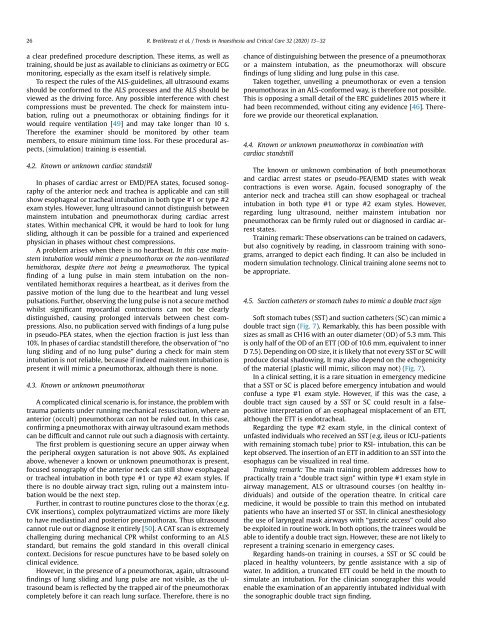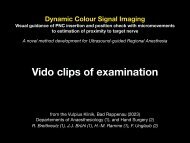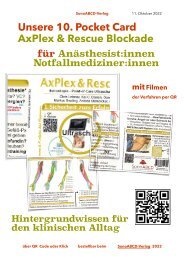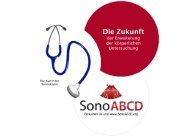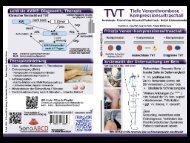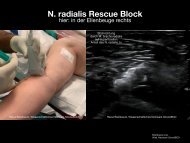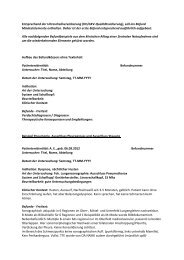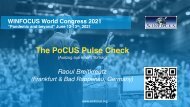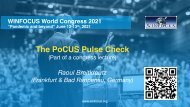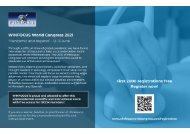Atemwegsultraschall - eine praktische Übersicht
Hier können Sie sich über das Thema umfassend informieren. Es sind zudem Filme innerhalb des Dokuments verlinkt. Es ist auch auf der Webseite des Publishers frei online verfügbar "Editor´s pick". https://authors.elsevier.com/a/1b66X7si0yR9sx
Hier können Sie sich über das Thema umfassend informieren. Es sind zudem Filme innerhalb des Dokuments verlinkt. Es ist auch auf der Webseite des Publishers frei online verfügbar "Editor´s pick".
https://authors.elsevier.com/a/1b66X7si0yR9sx
Erfolgreiche ePaper selbst erstellen
Machen Sie aus Ihren PDF Publikationen ein blätterbares Flipbook mit unserer einzigartigen Google optimierten e-Paper Software.
26<br />
R. Breitkreutz et al. / Trends in Anaesthesia and Critical Care 32 (2020) 13e32<br />
a clear predefined procedure description. These items, as well as<br />
training, should be just as available to clinicians as oximetry or ECG<br />
monitoring, especially as the exam itself is relatively simple.<br />
To respect the rules of the ALS-guidelines, all ultrasound exams<br />
should be conformed to the ALS processes and the ALS should be<br />
viewed as the driving force. Any possible interference with chest<br />
compressions must be prevented. The check for mainstem intubation,<br />
ruling out a pneumothorax or obtaining findings for it<br />
would require ventilation [49] and may take longer than 10 s.<br />
Therefore the examiner should be monitored by other team<br />
members, to ensure minimum time loss. For these procedural aspects,<br />
(simulation) training is essential.<br />
4.2. Known or unknown cardiac standstill<br />
In phases of cardiac arrest or EMD/PEA states, focused sonography<br />
of the anterior neck and trachea is applicable and can still<br />
show esophageal or tracheal intubation in both type #1 or type #2<br />
exam styles. However, lung ultrasound cannot distinguish between<br />
mainstem intubation and pneumothorax during cardiac arrest<br />
states. Within mechanical CPR, it would be hard to look for lung<br />
sliding, although it can be possible for a trained and experienced<br />
physician in phases without chest compressions.<br />
A problem arises when there is no heartbeat. In this case mainstem<br />
intubation would mimic a pneumothorax on the non-ventilated<br />
hemithorax, despite there not being a pneumothorax. The typical<br />
finding of a lung pulse in main stem intubation on the nonventilated<br />
hemithorax requires a heartbeat, as it derives from the<br />
passive motion of the lung due to the heartbeat and lung vessel<br />
pulsations. Further, observing the lung pulse is not a secure method<br />
whilst significant myocardial contractions can not be clearly<br />
distinguished, causing prolonged intervals between chest compressions.<br />
Also, no publication served with findings of a lung pulse<br />
in pseudo-PEA states, when the ejection fraction is just less than<br />
10%. In phases of cardiac standstill therefore, the observation of “no<br />
lung sliding and of no lung pulse” during a check for main stem<br />
intubation is not reliable, because if indeed mainstem intubation is<br />
present it will mimic a pneumothorax, although there is none.<br />
4.3. Known or unknown pneumothorax<br />
A complicated clinical scenario is, for instance, the problem with<br />
trauma patients under running mechanical resuscitation, where an<br />
anterior (occult) pneumothorax can not be ruled out. In this case,<br />
confirming a pneumothorax with airway ultrasound exam methods<br />
can be difficult and cannot rule out such a diagnosis with certainty.<br />
The first problem is questioning secure an upper airway when<br />
the peripheral oxygen saturation is not above 90%. As explained<br />
above, whenever a known or unknown pneumothorax is present,<br />
focused sonography of the anterior neck can still show esophageal<br />
or tracheal intubation in both type #1 or type #2 exam styles. If<br />
there is no double airway tract sign, ruling out a mainstem intubation<br />
would be the next step.<br />
Further, in contrast to routine punctures close to the thorax (e.g.<br />
CVK insertions), complex polytraumatized victims are more likely<br />
to have mediastinal and posterior pneumothorax. Thus ultrasound<br />
cannot rule out or diagnose it entirely [50]. A CAT scan is extremely<br />
challenging during mechanical CPR whilst conforming to an ALS<br />
standard, but remains the gold standard in this overall clinical<br />
context. Decisions for rescue punctures have to be based solely on<br />
clinical evidence.<br />
However, in the presence of a pneumothorax, again, ultrasound<br />
findings of lung sliding and lung pulse are not visible, as the ultrasound<br />
beam is reflected by the trapped air of the pneumothorax<br />
completely before it can reach lung surface. Therefore, there is no<br />
chance of distinguishing between the presence of a pneumothorax<br />
or a mainstem intubation, as the pneumothorax will obscure<br />
findings of lung sliding and lung pulse in this case.<br />
Taken together, unveiling a pneumothorax or even a tension<br />
pneumothorax in an ALS-conformed way, is therefore not possible.<br />
This is opposing a small detail of the ERC guidelines 2015 where it<br />
had been recommended, without citing any evidence [46]. Therefore<br />
we provide our theoretical explanation.<br />
4.4. Known or unknown pneumothorax in combination with<br />
cardiac standstill<br />
The known or unknown combination of both pneumothorax<br />
and cardiac arrest states or pseudo-PEA/EMD states with weak<br />
contractions is even worse. Again, focused sonography of the<br />
anterior neck and trachea still can show esophageal or tracheal<br />
intubation in both type #1 or type #2 exam styles. However,<br />
regarding lung ultrasound, neither mainstem intubation nor<br />
pneumothorax can be firmly ruled out or diagnosed in cardiac arrest<br />
states.<br />
Training remark: These observations can be trained on cadavers,<br />
but also cognitively by reading, in classroom training with sonograms,<br />
arranged to depict each finding. It can also be included in<br />
modern simulation technology. Clinical training alone seems not to<br />
be appropriate.<br />
4.5. Suction catheters or stomach tubes to mimic a double tract sign<br />
Soft stomach tubes (SST) and suction catheters (SC) can mimic a<br />
double tract sign (Fig. 7). Remarkably, this has been possible with<br />
sizes as small as CH16 with an outer diameter (OD) of 5.3 mm. This<br />
is only half of the OD of an ETT (OD of 10.6 mm, equivalent to inner<br />
D 7.5). Depending on OD size, it is likely that not every SST or SC will<br />
produce dorsal shadowing. It may also depend on the echogenicity<br />
of the material (plastic will mimic, silicon may not) (Fig. 7).<br />
In a clinical setting, it is a rare situation in emergency medicine<br />
that a SST or SC is placed before emergency intubation and would<br />
confuse a type #1 exam style. However, if this was the case, a<br />
double tract sign caused by a SST or SC could result in a falsepositive<br />
interpretation of an esophageal misplacement of an ETT,<br />
although the ETT is endotracheal.<br />
Regarding the type #2 exam style, in the clinical context of<br />
unfasted individuals who received an SST (e.g. ileus or ICU-patients<br />
with remaining stomach tube) prior to RSI- intubation, this can be<br />
kept observed. The insertion of an ETT in addition to an SST into the<br />
esophagus can be visualized in real time.<br />
Training remark: The main training problem addresses how to<br />
practically train a “double tract sign” within type #1 exam style in<br />
airway management, ALS or ultrasound courses (on healthy individuals)<br />
and outside of the operation theatre. In critical care<br />
medicine, it would be possible to train this method on intubated<br />
patients who have an inserted ST or SST. In clinical anesthesiology<br />
the use of laryngeal mask airways with “gastric access” could also<br />
be exploited in routine work. In both options, the trainees would be<br />
able to identify a double tract sign. However, these are not likely to<br />
represent a training scenario in emergency cases.<br />
Regarding hands-on training in courses, a SST or SC could be<br />
placed in healthy volunteers, by gentle assistance with a sip of<br />
water. In addition, a truncated ETT could be held in the mouth to<br />
simulate an intubation. For the clinician sonographer this would<br />
enable the examination of an apparently intubated individual with<br />
the sonographic double tract sign finding.


